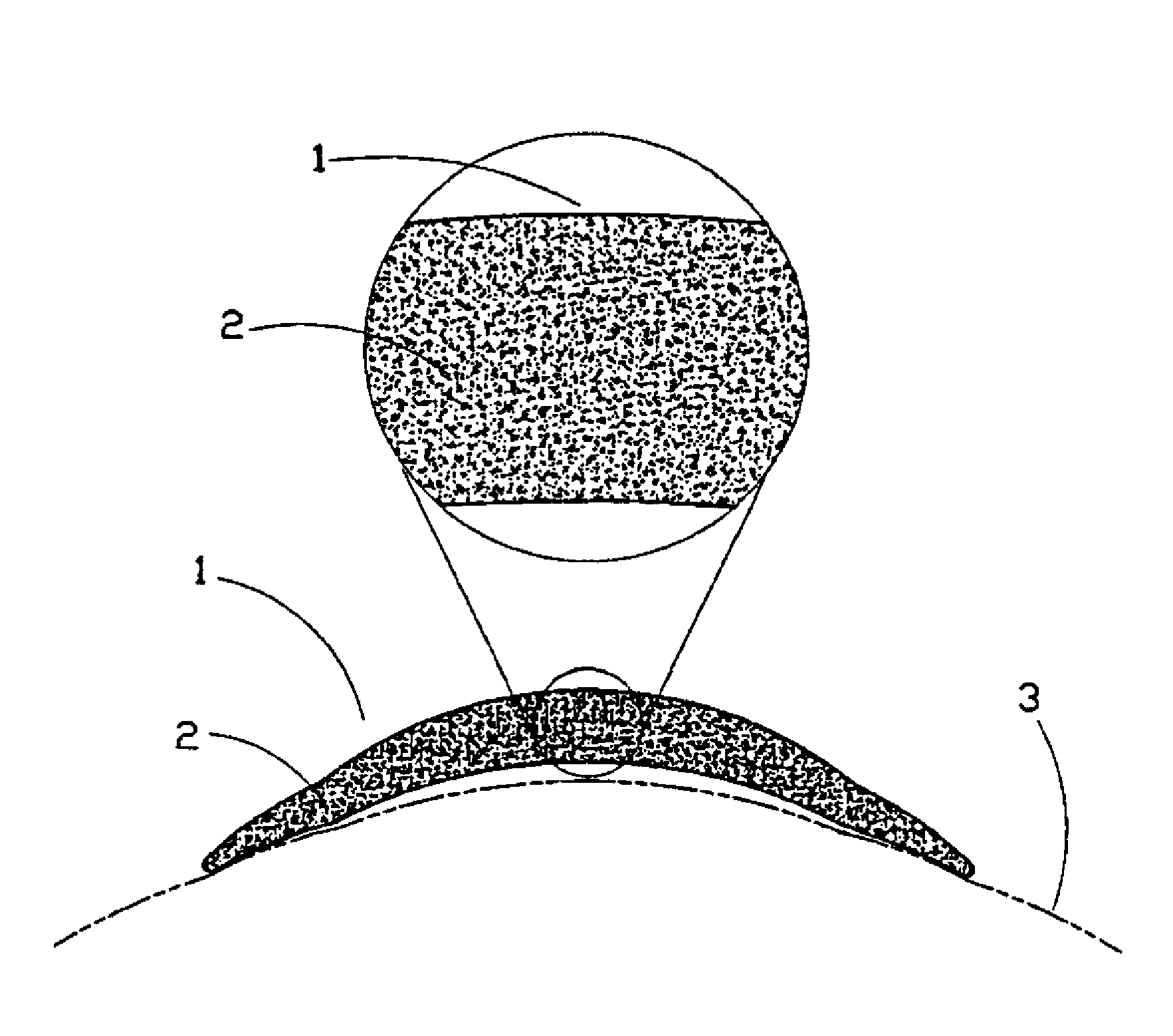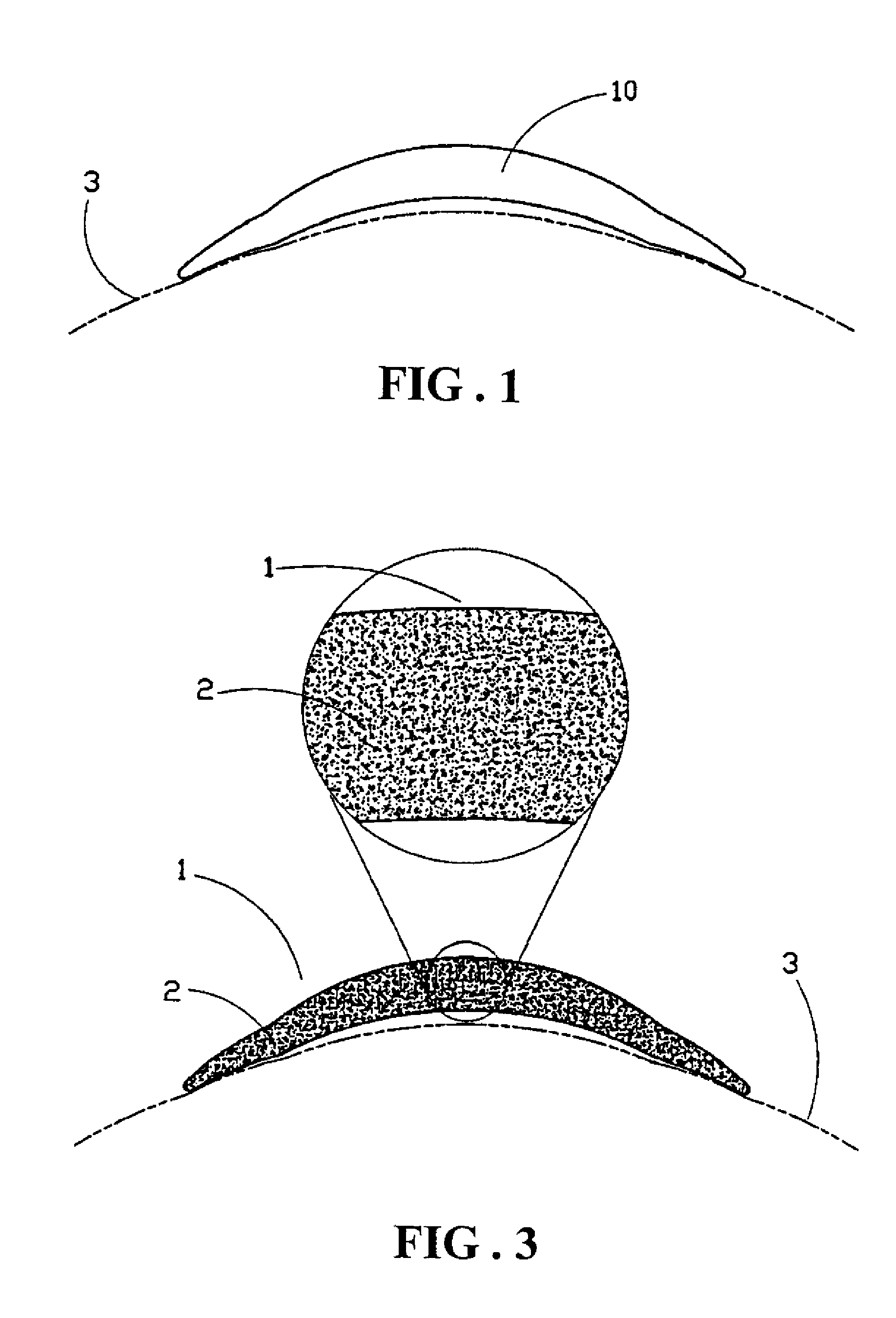Method for forming silicone hydrogel contact lens and structure thereof
a technology of silicone hydrogel and contact lens, which is applied in the field of forming a silicone hydrogel contact lens and the structure of the contact lens, can solve the problems of contact lens wearer, extreme discomfort, eye redness, etc., and achieve the effect of enhancing market competitiveness and effective reducing manufacturing costs
- Summary
- Abstract
- Description
- Claims
- Application Information
AI Technical Summary
Benefits of technology
Problems solved by technology
Method used
Image
Examples
example 1
[0023]Following chemicals are mixed to form a clear solution, which will be referred as Chemical I:[0024]methacryloxy propyl tris(trimethy siloxysilane) (TRIS) 47 parts;[0025]methyl methacrylate (MMA) 8 parts;[0026]N,N-dimethylacrylamide (DMAA) 42 parts;[0027]hydroxyethylmethacrylate (HEMA) 2 parts;[0028]ethylene glycol dimethacrylate (EGDMA) 1.5 parts; and[0029]2,2′-azobis(2,4-dimethylvaleronitrile) (ADVN) 1 part.
[0030]The solution of Chemical I is filled into the contact lens mold and a standard thermal polymerization process is carried out to form the lens. After de-molding, the lens is socked in water overnight and then kept in saline. The lens so formed is optically clear, but the lens is rigid and hydrophobic, therefore it cannot be used as a soft contact lens.
[0031]On the other hand, when mixing 86.6% of Chemical I with 19.4% of Dow Corning 5329, a clear solution was resulted. A contact lens made with the same process as described in the EXAMPLE 1 above, is optically clear an...
example 2
[0032]Following chemicals are mixed to form a clear solution, which will be referred as Chemical II:[0033]methacryloxy propyl tris(trimethy siloxysilane) (TRIS) 45.5 parts;[0034]methyl methacrylate (MMA) 8 parts;[0035]N,N-dimethylacrylamide (DMAA) 32 parts;[0036]1,1,1,3,3,3-hexafluoroisopropyl acrylate 10.5 parts;[0037]ethylene glycol dimethacrylate (EGDMA) 4 parts; and[0038]2,2′-azobis(2,4-dimethylvaleronitrile) (ADVN) 2.5 parts.
A contact lens was made by carrying out the same process as described in the EXAMPLE 1 above with Chemical II, is optically clear, however the lens is rigid and hydrophobic, therefore it cannot be used as a soft contact lens.
However, if a clear solution, hereinafter referred to as Chemical III, which is formed by uniformly mixing 4 parts of Chemical II with one part of Dow Corning 5329, is used to make a contact lens with the same process as described in the EXAMPLE 1 above, then the contact lens so made is optically clear and hydrophilic. The contact lens ...
example 3
[0042]Following chemicals are mixed to form a clear solution, which will be referred as Chemical V:[0043]methacryloxy propyl tris(trimethy siloxysilane) (TRIS) 46.5 parts;[0044]methyl methacrylate (MMA) 8 parts;[0045]N,N-dimethylacrylamide (DMAA) 30.5 parts;[0046]1,1,1,3,3,3-hexafluoroisopropyl acrylate 10.5 parts;[0047]ethylene glycol dimethacrylate (EGDMA) 4.5 parts;[0048]2,2′-azobis(2,4-dimethylvaleronitrile) (ADVN) 2.5 parts; and[0049]1,3-bis(3-methacryloxy propyl) tetrakis (trimethyl siloxy) disiloxane 1%.
A contact lens was made by carrying out the same process as described in the EXAMPLE 1 above with Chemical V is optically clear, however, the lens is rigid and hydrophobic, therefore it cannot be used as a soft contact lens.
[0050]When mixing 4 parts of Chemical V with one part of Dow Coming 5329. The contact lens made with the same process as described in the EXAMPLE 1 above, is optically clear and hydrophilic. The contact lens so made has water content of around 18%.
[0051]To ...
PUM
| Property | Measurement | Unit |
|---|---|---|
| Structure | aaaaa | aaaaa |
| Solubility (mass) | aaaaa | aaaaa |
| Water solubility | aaaaa | aaaaa |
Abstract
Description
Claims
Application Information
 Login to View More
Login to View More - R&D
- Intellectual Property
- Life Sciences
- Materials
- Tech Scout
- Unparalleled Data Quality
- Higher Quality Content
- 60% Fewer Hallucinations
Browse by: Latest US Patents, China's latest patents, Technical Efficacy Thesaurus, Application Domain, Technology Topic, Popular Technical Reports.
© 2025 PatSnap. All rights reserved.Legal|Privacy policy|Modern Slavery Act Transparency Statement|Sitemap|About US| Contact US: help@patsnap.com



